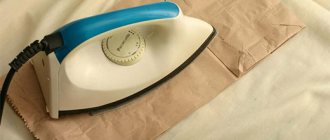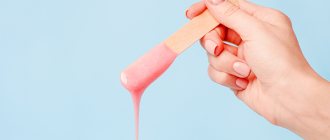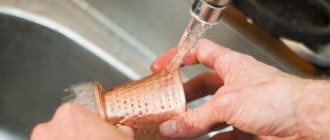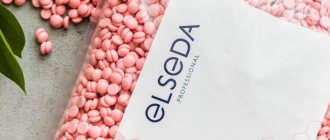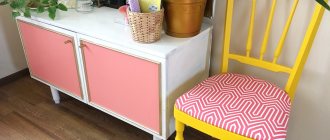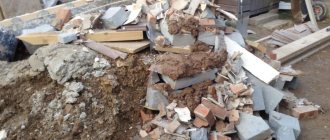Wooden furniture is incredibly popular among users. It is made from environmentally friendly, natural material, smells pleasant, and lasts a long time. No less practical, but inexpensive are products made from chipboard, laminate, MDF and other combined bases.
Despite its strength, any furniture deteriorates over time, wears out, and loses its attractiveness. To update its appearance and extend its service life, furniture wax has been developed - a universal composition that hides minor defects and protects surfaces from moisture.
Pros and cons of using
Unlike other products, the mixture does not lie on the surface of the wood, but penetrates its internal structure. The texture of the wood does not deteriorate, and the heat is retained for a long time. In addition, wax has the following advantages:
- The surface acquires a natural velvety feel to the touch; there is no glossy polishing.
- Furniture made from natural wood will sparkle with new and expressive colors.
- The range is presented in various tinting options: any furniture will harmoniously fit into the interior.
- In terms of its external composition, wax is a thick, dense mass that completely fills chips, cracks, scratches and other mechanical flaws.
There are many more pros than cons. The main disadvantages include the low protective level compared to the same varnish. It is also impossible to completely disguise marks and stains that form as a result of the harmful effects of moisture and sunlight.
Why do you need to wax wood?
The bee product has the priority right to be called wax. The rest of the products are artificial products of the chemical industry. Furniture and any wooden surfaces are subject to various physical impacts. This can cause minor damage (scratches, cracks) and lead to loss of presentation. Wood tends to release vapors from the internal structure of the material into the atmosphere, which causes cracks and drying out.
Since ancient times, people have polished floors and furniture with beeswax. A layer of greasy product masked small cracks and prevented the depletion of the wood mass due to evaporation. The process of treating surfaces with wax is called waxing. For many decades there has been an increase in the need for bee products, which have become scarce. As a result, new compositions were invented that were superior in properties to natural wax.
Types of material
There are many types of wax-based materials. The modern market offers the buyer the following varieties:
- Soft. Experts recommend using it to restore furniture and remove chips, dents and cracks. The restored surface can easily withstand physical stress. In addition to wood, the soft type is ideal for laminated flooring. No preparatory work is required; the mixture is sold ready-made. Using a plastic spatula, a certain amount of mass is applied to the dent or crack. If you need to create a specific color, several shades can be mixed with each other. Excess mass is removed with a spatula.
- Solid. The material has a dense structure. The solid consistency is ideal for both internal and external restorations. Easily copes with your favorite surface imperfections. Use a soldering iron to melt the wax. After this, it is applied to the damaged wooden structure. Within a matter of seconds, the mixture is completely absorbed into the layer. Excess is removed with a spatula.
- Liquid. It is customary to add synthetic components to its composition. Thanks to this, the consistency becomes liquid. This mass is easily applied to the surface using a brush or soft brush. It completely penetrates scratches and cracks, and is presented in stores as a creamy structure. It will take a minimum amount of time for the liquid to dry completely.
All varieties contain the following natural ingredients:
- Essential oils of coniferous plants;
- Tree resin;
- Drying oil;
- Beeswax;
- Olive, linseed oil.
In everyday life it is convenient to use a wax pencil for furniture - from scratches. It is available in a wide range of colors and has water-repellent properties. After its impact, the furniture looks like new. Used on varnished and laminated surfaces. Using furniture wax is very simple and convenient.
Basic properties and purpose
Modern cabinets and chests of drawers are subject to mechanical damage as a result of numerous moves and rearrangements, tables lose their attractiveness due to careless handling, so furniture wax remains in demand for minor repairs and care of products made of natural wood, laminate, parquet, chipboard and fiberboard. It is also suitable for repairing chips and cracks in window frames and doors. Furniture wax is used to treat panels, picture frames, wooden boxes and stair railings.
In addition to beeswax, the composition may contain synthetic resins, which give it greater durability, coloring pigment, and natural oils (for example, olive or linseed). Oil with wax provides light protection from moisture and a pleasant matte shine to wooden elements. The main purpose of the product is the renewal and restoration of products. A properly selected composition performs several functions at once:
- masks chips, scratches, small cracks;
- renews the surface of products, adding shine to them and emphasizing the texture of the wood;
- protects furniture from external influences, penetrating deeply into the structure of the material;
- used to enhance or slightly change the shade of wood;
- has antistatic properties, prevents dust from settling.
Products based on natural wax are very gentle on the texture of wood. They cannot radically change the color; they simply renew even heavily worn surfaces and give them a presentable appearance.
Manufacturers offer furniture wax for interior and exterior use; this should be taken into account when choosing a composition.
Varieties for interior use are less resistant to sunlight and moisture. The products differ in the form of release; it can be a hard bar, a pencil, or soft compositions with a texture reminiscent of Vaseline. Furniture wax can be colorless or tinted. In the second case, its shade should be as close as possible to the color of the surface being treated.
Rules of application
Short rules will help an amateur use furniture wax correctly and complete restoration work without errors:
- Surface preparation. For uniform impregnation, the pores of the wood must be open. If the furniture is factory-made and not covered with paint and varnish, then no preparation is required. If the surface is varnished, then to remove the top layer you will need the help of a solvent. They should treat the surface several times until the remaining varnish is removed. It is necessary to go through the direction of the fibers with sanding material.
- Applying wax. First you need to decide on the variety. The preparation of the necessary tools for the job depends on this. The soft look is rubbed in the direction of the wood grain using a thick cloth. If the choice fell on the hard type, then a spatula will be required to evenly rub into the surface. After applying the composition, the structure should be left alone for an hour. Then the excess wax mass is removed. To achieve a glossy effect, treat the wooden layer again.
Instructions for use
To work with a soft composition, you will need a rubber spatula, felt, and to open the package - a sharp knife. First, prepare the surface so that it is clean and the pores of the wood are open.
The defective area is cleaned of varnish (if it was previously applied) using a solvent, washed to remove dirt, and completely dried. To improve the absorbency of the composition, go over the base with sandpaper (in the direction of the fibers of the material).
Then proceed like this:
- open the wax package;
- scoop up the product with a small spatula;
- apply the composition to the damaged area, sealing the crack or scratch;
- rub the material with felt;
- the excess is carefully cleaned off with the same spatula or knife;
- leave the product to dry for an hour;
- polish the surface again to give it a glossy finish.
As a rule, a scratch is treated with hard wax in the form of a pencil without prior preparation. Some products involve preliminary melting and subsequent infusion into a crack or other defect. In this case, you will need a soldering iron or a hair dryer to work. If you don’t have such tools, you can use a gas torch or lighter. The heated material is applied to the problem area, leveled with a spatula, and after drying, polished with a soft cloth. Excess composition is removed with a blunt knife.
Self-production
The recipe is simple. Many experts prepare wax for furniture with their own hands. The solution is prepared in a water bath. To do this, you need to combine beeswax with turpentine. The first component must be thoroughly chopped with a knife, then placed in a container with turpentine. It should be half as much as beeswax. During the cooking process, the mixture should completely melt. To add thickness, the remaining wax is added to the finished solution. The main safety rule is careful handling of turpentine. It can easily ignite, so you should not keep it on fire for a long time.
As soon as the finished mixture has cooled, evaluate the degree of thickness. To make the solution more liquid, you need to place the container on the fire again and add turpentine. The resulting wax is stored in closed packaging.
During moving or long-term use of furniture, chips, cracks or scratches may appear. Replacing cabinet elements will entail serious financial expenses, and throwing furniture into a landfill can be a pity or impractical. Wax comes to the rescue, which easily gives the furniture its original appearance.
In order to learn how to use furniture wax, you do not need to have much experience, it is enough to learn the basic points of the work. This will allow you not to use paid services of specialists.
During the process of moving or using furniture, cracks, chips and scratches may appear. Sometimes finances do not allow you to buy a new one, and sometimes it is impractical because the furniture itself is in excellent condition. A professional product – furniture wax – will help in correcting damage.
This material is used in its natural form or in the form of special mixtures.
This universal product, designed for processing wooden products, can be used on both clean and laminated and varnished surfaces.
Wax can give a tree new life, improve its quality characteristics and appearance.
Such a mixture cannot be replaced with paraffin or other analogues painted in the desired color, since its texture and properties are different. This product is securely fixed in cracks and does not wash out.
Wax practically does not oxidize, and therefore is able to retain its properties for hundreds and even thousands of years.
Features of varieties
Furniture wax of soft and hard grades has its own characteristics.
Soft
Use it to get rid of scratches, chips, cracks and dents. Even if there are large broken edges or holes from self-tapping screws, this remedy will be effective.
In order to apply it yourself, you must follow these recommendations:
- To restore objects, the product must be rubbed in thoroughly.
- Use an edge knife to apply wax to the edges. The missing piece of furniture should also be formed from it. You need to level the surface using a spatula.
- Excess pieces of material are cut off with a knife. Smooth the plastic surface with a corner.
- You can use a felt cloth to polish the repaired surface.
Using such a pencil, you can restore patterns on furniture.
Solid
Such wax pencils have the same purpose as soft ones.
They differ in that:
- have a high degree of protection against mechanical damage,
- can be used for DIY restoration, but only after melting,
- their price is higher than soft ones,
- they are not easy to find,
- There are few color varieties.
The features of removing scratches with your own hands using this product are the same as in the case of soft ones. But a hard pencil must first be melted using a lighter, blowtorch or torch.
Types of furniture wax
Mixtures are divided into the following types:
Soft wax makes wood surfaces smooth and provides the desired shade to the wood texture.
This wax is preheated to make the wood material softer and the application better.
Soft is used if you want to update the appearance of furniture and give it a more attractive appearance, remove minor scratches and small cracks, repair shallow dents and chips.
This type of product is quite easy to use.
Before applying it, it is necessary to prepare the area for treatment - wipe it dry, remove any remaining paint or varnish, if any. Then the product is applied by rubbing in the required amount and left for 25 minutes.
The main advantage of this coating is that the wax penetrates the wood rather than remaining on the surface.
The excess is removed with a knife, and the treated area is polished with a felt rag or cotton napkin. If the scratches are significant, the holding time can be increased.
This type has a richer palette of colors than the solid type.
Restoration of laminated surfaces
If you need to put the laminated surface in order, then you should familiarize yourself with the following recipe. To prepare it, prepare the following ingredients:
- 100 grams of wax; 25 grams of rosin; 50 grams of turpentine; propolis.
- Melt the substance in a water bath. After dissolution, add rosin. Carefully pour in the turpentine. To make the solution acquire a pleasant smell, you can add a little propolis to it. Pour into a container and cool. Apply with a soft cloth.
Thanks to this processing you will receive:
- water-repellent surface; disguised scratches and minor defects; filled joints; beautiful matte shine; pleasant aroma.
Advantages and disadvantages of use
Professional wax is an excellent solution if you want to update the appearance of furniture, and, objectively, this product has much more advantages than disadvantages.
In addition, its use can replace varnish, which in some cases contains harmful substances and has an unpleasant odor.
Among its advantages it is worth noting:
- Good moisture-repellent properties;
- Removing chips, cracks, filling joints and giving furniture a new look;
- Nice shine;
Wood coated with wax becomes silky and shiny.
With the help of wax, the wood texture is perfectly restored, abrasions and various types of defects are removed, the color becomes richer and softer.
Among the disadvantages of using such a product are the low protective properties for furniture compared to varnish. In addition, they cannot “cover up spots” that appear under the influence of sunlight, moisture and other factors.
If there are stains, then you must first bleach the wooden surface.
LiveInternetLiveInternet
–Tags
–Categories
- PICTURES FOR DECOUPAGE (1096)
- CULINARY RECIPES (537)
- MK ON DECOUPAGE (384)
- HANDCRAFTS. (229)
- INSPIRATIONALS (225)
- VIDEO MK ON DECOUPAGE AND DECOR. (225)
- SCRAPBOOKING (171)
- INTERESTING TECHNIQUES IN DECOUPAGE AND DECOR. (170)
- MY WORKS. (130)
- MATERIALS, TOOLS (110)
- IDEAS FOR Cottages AND HOMES. (91)
- PHOTOSHOP and PAINT.NET LESSONS (77)
- SEWING. (76)
- MOLDING, POLYMER CLAY, COLD PORCELAIN, SALT TE (66)
- BOHO (64)
- LI.RU, UTILITIES (54)
- TOPIARY,FLORISTICS (48)
- GARDEN AND VEGETABLE VEGETABLE (47)
- FOR PAINTING WITH PUTTY (46)
- WORKSHOP, WORKPLACE (44)
- PACKAGING, BUSINESS CARDS, TAGS (37)
- BEAUTY AND HEALTH. (thirty)
- FOAMIRAN. (23)
- TREATING WOODEN SURFACES (tips) (21)
- NEWSPAPER WEAVING, (18)
- MANDALA. (16)
- DRAWINGS FOR BLANKETS (16)
- HOME CELLAR (14)
- MY MK. (eleven)
- GYPSUM (10)
- LEARNING TO PHOTOGRAPH YOUR WORK. (8)
- Stencils (8)
- BOOKS ON DECOUPAGE (8)
- PRODUCTION OF BLANKS FOR DECOUPAGE AND DECOR. (6)
- MAGAZINE_DO IT YOURSELF (4)
- TILDES, TOYS (2)
- LINKS TO VIDEO MK ON DECOUPAGE (2)
-Video
-Music
–Search by diary
–Subscription by e-mail
-Friends
-Statistics
How to choose the right one
The choice of restoration product depends on the color, type and composition. The color palette is quite impressive.
Finding a suitable color will not be difficult.
Almost all types are based on the same composition containing natural substances:
- Wax (beeswax or carnauba);
- Oils (olive, linseed, etc.);
- Coniferous esters;
- Wood resin;
- Drying oil.
To give the required consistency and properties, artificial solvents, UV filters and other additives are added.
The choice of consistency depends on the area of the damaged surface and the depth of the cracks. Liquid wax is suitable for shallow multiple scratches.
It is better to choose a solid mixture if the chips and cracks are large and require careful restoration.
Apply the wax by simply pressing it into the surface and then rub it with a spatula.
Soft is valued for its rich color palette and ease of use.
The color is quite stable and will not fade over time.
Wax comes in different forms. To remove minor damage, it will be convenient to purchase a wax pencil.
Wax pencil is the simplest and most economical solution for furniture restoration.
To process a large area, it is better to purchase bulk containers.
Features of using a wax pencil when repairing laminate flooring
Wax pencil for laminate is used in general according to the same principle as described above. It is suitable for repairing minor damage. The main advantage of this tool is ease of use. The mixture is environmentally friendly, because the ingredients do not contain harmful substances. To carry out the work you will need:
- dry and wet rags;
- wax pencil for laminate;
- vacuum cleaner.
You should not go to the store without taking a sample of the flooring with you, because you will not be able to choose the right shade. Once you have managed to buy a pencil, you can begin to process the surface; to do this, it is cleaned of dust, grease, debris and other contaminants. The base is left to dry, only then can you begin applying the pencil.
As soon as the damaged area is hidden, you need to leave it for a few minutes, and then you can start polishing the treated surface with a dry cloth. This will remove excess wax. After about an hour, you will be able to use the restored surface without noticing that there was ever any damage there.
How to use
In order for the product to be well absorbed into the wood, it is necessary to prepare the area to be restored. To do this, you need to remove dust. The coating should be removed from a varnished or polished surface using a solvent.
If necessary, the wood is bleached.
Depending on the type of wax, various tools are used for its application: spatula, brush, brush, etc. The finished composition is applied in a very thin and even layer. It is better to leave any mixture on the surface for at least an hour for better adhesion and hardening. Excess is removed with a knife and polished with a napkin.
To achieve a beautiful shine, the treatment must be carried out twice.
What is
Oil-wax for wooden furniture is a material used for polishing interior items.
As a result of its use, a protective coating with good performance characteristics appears on the surface.
The main components of the material, as the name implies, are oil and wax. The first agent penetrates even into the lower layers of wood, protecting it from external negative influences, preventing the destruction of the solid structure. Wax forms a hard coating on the surface. It also protects the wood from external negative influences, and also increases the attractiveness of the furniture.
Waxing furniture: advantages and disadvantages
Waxing furniture is a type of finishing that has been known for many centuries. As a rule, the surface of the products is coated with wax, after which it acquires a slight shine and increased resistance to moisture.
Benefits of waxing furniture
In addition, wax emphasizes the color of the wood, although not as clearly as, for example, oil. Also, this method of processing furniture can complement and smooth out minor defects.
Generally, waxing works great on cabinets or dressers.
Moreover, wax works as an antistatic agent, which helps prevent large amounts of dust from settling on furniture.
Some disadvantages of waxing furniture
Of course, wax is not as durable as, for example, varnish, so it should be renewed once a year, in addition, it is recommended to completely remove all layers of wax every few years and wax again.
It is not advisable to use this treatment on heavily used furniture, such as chairs, tables, kitchen countertops, as the surface will wear off quickly.
Also, the disadvantages of wax include its sensitivity to high temperatures, so it is not recommended to place hot objects on such surfaces, and it is also undesirable to plan furniture close to radiators or a fireplace.
Work methodology
Once the wax pencil has cooled, you can use a blade to remove the excess, smoothing the surface with your finger. At the final stage, a varnish for repair work is applied; it will be most convenient to use one that is made in the form of a spray. Then the entire surface of the piece of furniture is treated with liquid wax or polish, this will give the base a well-groomed appearance and pristine shine.
Basic working steps for applying wax to furniture
The work requires a little time and patience. Wax can be applied to raw wood furniture, as well as to surfaces treated in the same way.
It should be borne in mind that changing the color of furniture using paint or stain will not be possible on already waxed surfaces, since the paint or stain simply will not stick to the furniture.
The surface is first prepared for waxing; as a rule, the furniture is cleaned and sanded with sandpaper.
After which the wax is gently rubbed into the wood in a circular motion, and then smoothed along the grain.
For these purposes, cotton fabric is used, which does not leave threads or hairs. For small or carved elements, it is best to use liquid wax, which can be applied with a brush.
It is recommended to treat furniture in several thin layers, rather than one thick one, so that the wooden surfaces are not greasy.
After drying, in most cases this takes several hours, the wax layer is wiped with a cloth until shiny, and then subsequent layers are applied.
Choice of product
When purchasing wax, you need to follow a number of rules. First of all, the specific problem is taken into account: if a small scratch appears on the furniture, it is easier to remove it with a wax pencil; if there is a large chip, you should buy a paste-like (soft) material. Also, when selecting, carefully consider the shade of the product - it must match well the color of the product itself, otherwise it will stand out on it in the form of a spot.
Waxes for outdoor use must have powerful water-repellent properties and contain components that prevent them from fading from ultraviolet radiation. To restore a large surface or to completely renew furniture, it is worth buying wax in large containers, which is much more profitable.
Some types of waxes
Colorless types are available for sale; as a rule, they are intended only for moisturizing and polishing wood without changing its color.
Waxes with a small amount of dye slightly highlight the color of the wood, but do not change it.
There are also waxes with a higher pigment content, usually used for a more intense expression of the desired color range.
You can make your own wax by combining beeswax with turpentine, and if necessary, with dye.
How to use a wax marker correctly
How to properly paint over a scratch on a car? The process of repairing a car body using an anti-scratch wax marker is extremely simple. But in order to achieve success, you must carefully and scrupulously follow each point of the below scratch removal algorithm:
- Prepare the room. Firstly, the temperature should not be less than 10 degrees Celsius - otherwise the paint may not adhere well. Secondly, the room must be well ventilated. This measure is due to the fact that wax pencils can emit toxic fumes during use. Thirdly, the room should have good lighting.
- Prepare the car. The surface of the damaged area must be thoroughly degreased and dried. If rust has already appeared on the scratch, all traces of it must also be carefully removed.
Result of removing a scratch using a wax marker
- Now you can get to work. The paintwork must be applied gradually and evenly. If possible, try not to get paint on undamaged areas of the surface. If the scratch on the car is deep, it is better to go over it with a pencil several times - this will make it possible to completely level it with the surface of the car.
- After the scratch has been completely painted over, you can remove the remaining paint from the surface of the car using a napkin. It is better to do this when the coating has not yet dried.
- Don't forget to close the cap of the marker - its contents have the very unpleasant property of drying out very quickly when exposed to air. If there is dried paint coating left on the tip of the pencil after painting, you can cut it off with a knife.
How to properly use wax to repair furniture
- Prepare the work area. On oak, walnut, ash and other solid surfaces without paintwork – just remove dust. If the area to be treated is varnished, remove it with a solvent.
- When restoring with any type of wax, the composition must be soaked and dried. Time – at least 50-60 minutes. Excess mixture is removed with a knife or a piece of plastic, and the areas where furniture has been restored are polished with a napkin or a clean piece of soft cloth.
After waxing, the furniture must be polished with a napkin or soft cloth.
Wax pencils (soft and hard)
Wax pencils are suitable for restoring furniture with a small surface area to be treated. The consistency depends on the nature of the defects. The consistency of wax pencils for furniture is selected based on the defects present. For deep cracks, chips and scratches, it is better to choose a hard pencil. It is suitable for wooden window frames on the street side, and for restoring interior elements that are regularly exposed to sunlight. It has good plasticity and adhesion.
Hard wax pencils are suitable for deep cracks, chips and scratches on furniture. Hard wax must be melted before application. To do this, you can use a soldering iron, a special wax melter, or even a household hair dryer if it is capable of bringing the temperature of the material to 95 degrees. This is exactly how much is needed to melt hard furniture wax. Before using hard wax pencils, they need to be melted.
Liquid
Liquid. Its thickness resembles drying oil. Suitable for repairing horizontal and inclined surfaces. You can apply it with a spatula, a piece of plastic, or even a clean cloth. Large selection of shades.
You can apply liquid wax to furniture using a brush or soft cloth. The choice of mixture mainly depends on the nature and area of damage. And, of course, it is better to buy products from well-known manufacturers. Because at home you are unlikely to be able to check furniture wax for the presence or absence of toxic additives.
